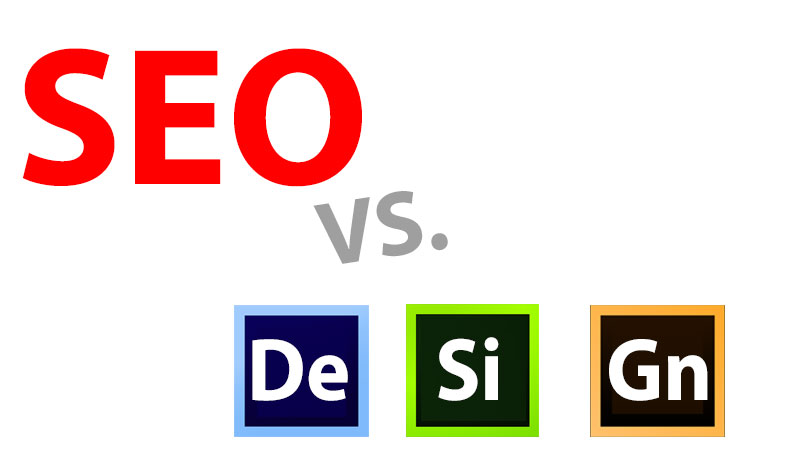
Why SEO and Design Need to Get Along
Being a Designer / Developer in an Internet Marketing environment can set forth a conflict of interest. While design and development often complement one another SEO often lives on its own set of standards which conflict with many aspects of a “good design.”
Unfortunately, SEO by nature is not pretty. On the other side, many design tactics used widely around the web can cripple SEO for a site. The main question stands as:
Where can SEO and Design / Usability meet and be most effective for my site?
It is not a simple question to answer and many factors go into deciding where you want to draw the line. If your main focus for your site is to purely increase search engine traffic than you most likely would want to focus more on SEO than design.
On the other hand if your site already gets a decent amount of traffic per month and you are more concerned about your sites conversion rate and ease of use you may want to consider eliminating some SEO for a simplified, clean, user-friendly layout.
Many designers consider the use of on-page SEO as a major hit to effectively displaying content on the web space. On-page SEO is effective but using it incorrectly can not only cripple your contents usability it can in some cases get you “Google Slapped.”
What is on-page SEO?
On-page SEO refers to any SEO tactics used on the website itself. This does not include other tactics such as Link-Building or Social Media. On-page SEO focuses on the use of keywords used in site content and title, Meta and alt HTML tags. While the usability of a site is generally not hindered by optimizing the Meta and Title tags of a page on-page SEO can get hairy when the content is “over-optimized” let me give you an example.
For example, say you have a site about dogs and a user wanders along and finds your site on the web. The user most likely will happen across your sites homepage (as this page is often the most indexed page by the SERPS).
You have version “A” of your homepage with a typical header area and some lengthy copy underneath the navigation containing your sites main keywords every 120 words or so. Version “A” of the homepage has around 500 words which lets you display your keyword 5 times without being penalized by the SERPS.
It has been proven that people who use the web ‘scan’ content in an “F” shaped pattern. The further down the page a user ‘scans’ the less content they actually read and digest as complete information. It is becoming increasing important to display your content in brief concise blurbs of content that is easy for the user to quickly determine what the whole piece of the content is about. Long content pages on the web (aside from blogs or news articles) are becoming a thing of the past. The internet is regarded to be a resource for quick information, and if a user can’t determine what information they are looking for within a few seconds of being on a sites page they usually bounce from your site.
Now say you have a version “B” of your homepage with a unique layout that directly displays your main purpose of your site and what you can offer to the user who visits the site. Now, beneath the above mentioned area you have a short 150-200 word blip about the site and target a few keywords.
Compare “A” vs. “B” and can you guess what might happen?
I would be more than willing to bet that version A would get more traffic, but would it have a high click through rate? There is no doubt that the pure SEO points of the “A” version is better. However, the content placement for the user on version “B” is much more intuitive and easier to digest by the mind in a few seconds.
I have heard before that Search Engine Spiders are trained or programmed to think like humans. While that may be true in some cases one thing is surely not the same.
Search Engines do not have eyes!
You may be saying Duh…, but let me explain.
Google and the other major search engines read page content word for word 100% of the time. They have to; this allows them to take proper action to people who are using black hat SEO. Google’s algorithm knows that if your site has a targeted keyword or dog training a content block with dog training displayed 4 times that your site is about you guessed it.
Dog Training.
However, the reality is that users very rarely ever read the entire pages content. We as modern day human beings are too impatient. It is at this point where design and conversion optimization can do more good for your site than pure traffic alone.
Number 1 is not always a good thing.
You see many SEO agencies advertising a guaranteed #1 ranking for specific keywords. Not only is this impossible to guarantee but often times the # 1 spot is not ideal in certain situations.
To reference my previous example, version “A” may rank number one for “Dog Training” but if the site does not convert that traffic into leads or at least an extended time on time per user guess what the user’s second choice is…
The #2 Listing on the Search Page, and 99% of the time this is your competitor.
Whereas, the version “B” of your homepage may be a number 2 ranking for Dog Training, and get plenty of traffic and you can convert that traffic into extended time on site, leads and more importantly cash in your pocket.
It is the same concept of two stores selling a similar product side by side. One may have a great product but an unattractive storefront. The other a bright eye catching obvious first impression with a good product.
If I were to look at these stores with no prior knowledge of them I’m going to the bright storefront 99% of the time because of the impression that it gives me.
Don’t get infatuated with being the number one choice on Google if you are converting a meager percentage of that traffic into leads. It is not worth the time, money and more importantly lack of usability to gain a bit more traffic each month. Instead focus on conversion optimization to take advantage of the traffic you have.
The idea is that sometimes less is more.
But What if I Want More Traffic to my Site?
As stated earlier there are other SEO strategies on the web, some of which are regarded as more relevant to the SERPS than on-page SEO. Some of these methods include link-building and social media.
Link-building can drastically increase your sites search engine relevance if done morally and correctly. For our example above perhaps you were to find another highly regarded blog in the Dog Training industry. It would be beneficial to inquire about getting a link from their site back to yours. SERPS translate links to your site as votes and obviously the more votes the better. There is a lot more to it than that but you get the idea. Learn more about this practice in our article about How to Ask for Links to Your Site.
Social media such as Twitter and Facebook can drive followers or friends from your networks to your site if you are active in them while these don’t improve your ranking on Google as dramatically they can effective steer social media users to your site and if they like your content (blogs are a good example) they may bookmark it or share it with their followers.
Most newsletters suck...
So while we technically have to call this a daily newsletter so people know what it is, it's anything but.
You won't find any 'industry standards' or 'guru best practices' here - only the real stuff that actually moves the needle.







